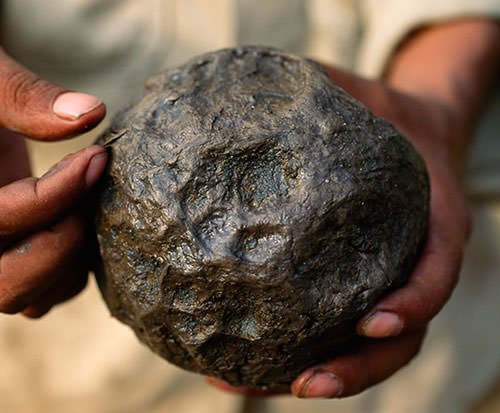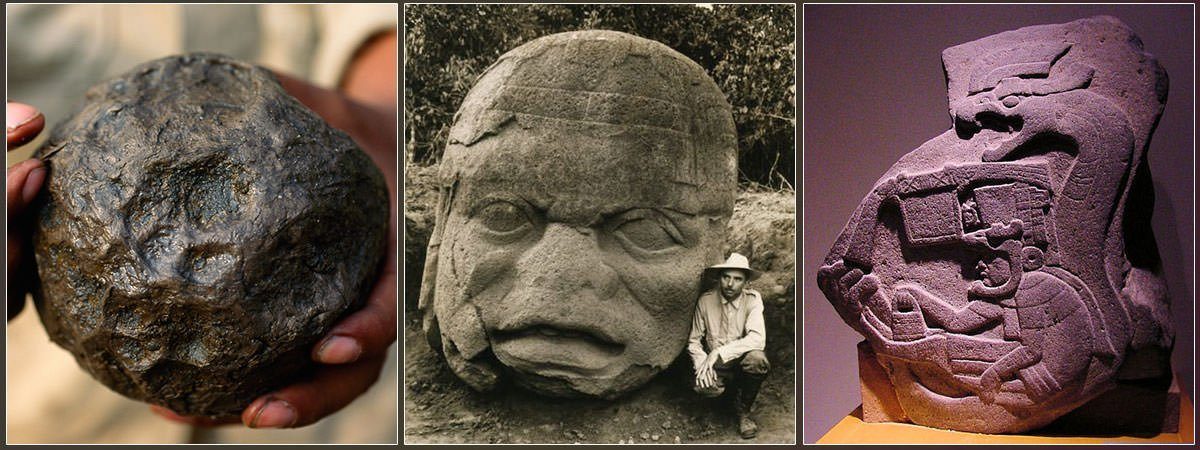The Olmec is the earliest known major civilization of Mesoamerica or Pre-Columbian America. It is thought that early Olmec culture appeared around 1600 BC and it flourished from 1200 BC to 400 BC in the tropical lowlands of south-central Mexico, in the present-day states of Veracruz and Tabasco. The Olmec are credited with building the first major city in Mesoamerica and constructing the earliest known Mesoamerican pyramid. Little is known about the Olmec and they remain a mysterious civilization. What is known is that they laid many of the foundations for all subsequent Mesoamerican cultures such as the Maya and the Aztec. Many of the hallmarks of Mesoamerican societies, like ritual bloodletting and the famous ballgame, were initiated by them. The Olmec culture disappeared around 400 BC but the cause of its extinction is not known. Know more about the ancient Olmec civilization through these 10 interesting facts.
#1 OLMEC CULTURE WAS UNKNOWN TO HISTORIANS UNTIL THE MID-19TH CENTURY
In late 1850s, a farm worker discovered a colossal head near the Olmec site of Tres Zapotes in the Mexican state Veracruz. In 1862, hearing about the find, Mexican antique collector Jose Melgar visited the site and completed the partially exposed sculpture’s excavation, thus beginning the re-discovery of the long lost Olmec culture. In 1869, he published its description. During the next 50 years, occasional pieces of Olmec artifacts were discovered, bringing to light a unique artistic tradition. In the late 1930s and 1940s, American archaeologist Matthew Stirling carried out the first detailed scientific excavations of Olmec sites. In 1942, a conference on the Olmecs was held at Tuxtla Gutiérrez. Here, Mexican scholars argued that the Olmec preceded Classic Mesoamerican cultures like the Maya; while American scholars maintained the position that the Olmec culture was contemporary with the Maya. Modern archaeological techniques entered the field of Olmec studies in 1955 and soon established with certainty that the Olmec were an archaeological culture, rather than simply an art style; and that they belonged to the Pre-Classic period, before the Maya

#2 THE OLMEC REMAIN A MYSTERY AND WE DON’T EVEN KNOW WHAT THEY CALLED THEMSELVES
Much of what we know about the Olmec civilization is dependent solely on archaeological evidence. As a result not much is known about the Olmec and, though evidence points at several possibilities, most of the things have not been established with certainty and are presently debated. We do not even know whom we call the Olmec, called themselves. The term “Olmec” was an Aztec name for the people who lived in the Olmec heartland in the 15th and 16th centuries, some 2000 years after the Olmec culture had died out. In Nahuatl, the language used by the Aztec, they were called Ōlmēcatl. The word ōlli means “rubber” while mēcatl means “people”. Thus the term may be translated as “rubber people”. The Aztec used the term due to the ancient practice in the region of extracting latex from rubber trees and mixing it with juice from morning glory vines to produce rubber.

#3 THE OLMEC ARE REGARDED AS THE “MOTHER CULTURE” OF MESOAMERICA
Mesoamerica is a term used to describe the region roughly corresponding to modern day Mexico and Central America which was inhabited by various societies before Spanish colonization following the famous discovery by Christopher Columbus. It is one of the six sites that current scholars consider as cradles of civilization, where civilization emerged independently. The Olmec civilization prospered from around 1400 BC to 400 BC in the formative period of Mesoamerica. It is regarded as the first major Mesoamerican civilization with many historians calling it the “mother culture” of Mesoamerica. The earliest evidence for Olmec culture is found at the site of El Manatí in the Mexican state of Veracruz. Its artifacts have been dated to 1600 BC or earlier. It is speculated that the Olmec had their roots in early farming cultures of Tabasco, which began between 5100 BC and 4600 BC.

#4 THE FIRST MAJOR OLMEC CITY WAS SAN LORENZO TENOCHTITLÁN
San Lorenzo Tenochtitlán was the first Olmec site that demonstrates state level complexity. Distinct Olmec features occurred at this site around 1400 BC. San Lorenzo was situated in the midst of a large agricultural area. Its environment may be compared to other ancient centers of civilization: the Nile, the Indus, Yellow River valleys and Mesopotamia. This highly productive environment must have encouraged a densely concentrated population. This in turn gave rise to an elite class creating a demand for sophisticated luxury artifacts which came to define the Olmec culture for the modern world. Apart from other things, San Lorenzo had an elaborate drainage system which used buried, covered, channeled stones as a type of “pipe”.

#5 THEIR CITY LA VENTA WAS THE MOST INFLUENTIAL CITY OF MESOAMERICA OF ITS TIME
The first Olmec center, San Lorenzo, was abandoned around 900 BC. At the same time, the Olmec city of La Venta rose in prominence to become the civic and ceremonial center of the Olmec civilization. The most prominent theory regarding the change in Olmec centers is that it was due to important rivers changing course. The central building at La Venta is known as The Great Pyramid. It was the largest Mesoamerican structure of its time and it is the earliest known Mesoamerican pyramid. It is thought that the Great Pyramid was a stand-in for a sacred mountain in religious ceremonies. North of the Great Pyramid (Complex C), is a restricted sacred area (Complex A); while to the south is Complex B, which seems to have been built specifically for large public gatherings. At its height, La Venta was home to thousands of people and directly controlled an area of around 200 hectares. It is considered to be the greatest and most influential city of Mesoamerica of its time.

#6 THE CAUSE OF Their EXTINCTION IS NOT KNOWN YET
La Venta was abandoned by the Olmec around 400 BC and this is regarded as the end of the Olmec civilization. Apart from San Lorenzo and La Venta, the two other important cities of the Olmec were Tres Zapotes and Laguna de los Cerros. There are various theories on what caused the eventual extinction of the Olmec civilization. One states that it was a result of “very serious environmental changes that rendered the region unsuited for large groups of farmers”. These changes may have been caused by tectonic shifts or the silting up of rivers due to agricultural practices. Another theory states that volcanic eruptions around that period forced the Olmec to move their settlements. This theory thus suggests relocation of settlements, instead of extinction. Successor cultures became established in the Olmec heartland. They are often referred to as Epi-Olmec or Post-Olmec culture.
#7 MOST FAMOUS ASPECT OF THEIR CIVILIZATION IS THEIR ARTWORK
The Olmec civilization produced the earliest sophisticated art in Mesoamerica and their distinctive style provided a model for later civilizations in the region like the Maya and the Aztec. Hallmark of Olmec art is the incredible attention to detail which can be found in not only miniature works but also in monumental stone sculptures. Olmec carvers had complete mastery over the difficult miniature medium and they created the most exceptional jade artworks by any Mesoamerican culture. However the Olmec are most known for their monumental sculptures, especially the 17 colossal heads which have been found at various Olmec sites. They vary in height from 1.47 to 3.4 meters (4.8 to 11.2 ft.) and are estimated to weigh between 6 and 50 tons. It is not known with certainty who these massive monuments represent. The most widely accepted theory is that they are portraits of powerful individual Olmec rulers. There is a great deal of speculation regarding how the Olmec accomplished various tasks required to create these colossal heads like transporting such massive stones to the sites. The Olmec colossal heads are the most famous legacy of their civilization.

#8 THEY HAD A CLASS STRUCTURE CONTAINING AT LEAST THE ELITE AND THE COMMONERS
Little is known about the social or political structure of the Olmec. However, it is known that they transformed from a society of farmers into the class-based social structure with leaders and commoners. San Lorenzo shows clear evidence of class structure with more elaborate housing for the upper classes and simpler accommodations for the commoners. It is also not known whether the Olmec were a unified state with a single political identity. Several researchers believe that they were probably a collection of chiefdoms which rose and fell over time and shifted alliances. There is much speculation about the Olmec but evidence do suggest that they must have contributed significantly to Mesoamerican culture. They are credited by several prominent researchers for many things including being the first Mesoamerican civilization to develop a writing system, for inventing the famous Mesoamerican Long Count calendar and for discovering the compass a millennium before the Chinese.

#9 RELIGION PLAYED A KEY ROLE IN THEIR SOCIETY
Religion significantly influenced the Olmec world. However, as there is no surviving direct account of their religious beliefs, archaeologists have used other techniques to reconstruct Olmec beliefs; like typological analysis of Olmec iconography and art, and comparison to later well documented Mesoamerican cultures. It is believed that Olmec religious activities were carried out by rulers, full-time priests and shamans with the ruler being the most important figure. Olmec deities include the Olmec Dragon, which has flame eyebrows; the Maize God, which grows corn from his cleft; the Feathered Serpent deity; the Fish Monster, recognized by its shark tooth; and the Banded-eye God, which has a narrow band that runs along the side of its face through its eye. Also, researchers have found evidence that suggest the Olmec practiced bloodletting, a ritual which was performed by self-piercing a body part and sacrificing the blood as an offering to the gods.

#10 THERE IS AN ALTERNATE ORIGIN THEORY LINKING THE OLMEC TO AFRICANS
As very little is known with certainty about the Olmec, there are a number of Olmec alternative origin speculations. When Jose Melgar first discovered one of the colossal heads built by the Olmec, he immediately supposed that his find was evidence of ancient contact between Africa and ancient inhabitants of the Americas. This was based on the fact that the features of the colossal head resembled individuals of African descent. Based on the facial features of Olmec statues, this claim continues to appear occasionally in both popular and scholarly journals. Guyanese-born American scholar Ivan Van Sertima wrote a popular 1976 book titled They Came Before Columbus supporting the theory of African origin of the Olmec. Mainstream scientists and scholars point out that there is no genetic evidence to support this claim and that native inhabitants of the region also have similar facial features.


B E A U T I F U L website. love it .
Thanks for your appreciation.
IVAN WAS CORRECT THAT WAS NOT SOME “THEORY “ A PLETHORA OF EVIDENCE WAS FOUND REGARDING AFRICA MAKING CONTACT WITH THE OLMAC CIVILIZATION, YET PEOPLE WANT TO JUSTIFY THE TRUTH FOR THEIR OWN SATISFACTION, THEY REFUSE TO GIVE CREDIT TO THE ONES WHO DESERVE IT…CHRISTOPHER COLUMBUS “DISCOVERING AMERICA” WERE LIES, YOU CAN’T DISCOVER SOMETHING THAT PEOPLE ALREADY LIVED ON!! THIS CRIMINAL WAS A SADISTIC MENTAL CASE.
RESEARCH HOW CHRISTOPHER COLUMBUS REALLY WAS EVERYONE HATED HIM HE WAS A SNAKE, ALSO FULLY RESEARCH AFRICA AND THE OLMAC CIVILIZATION IT GOES WAY DEEPER THAN THIS ARTICLE.